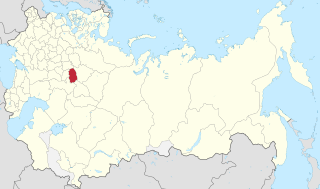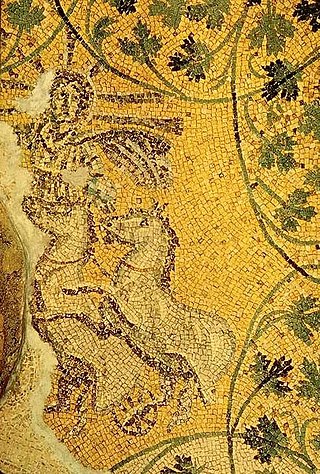
Catacombs are man-made underground passages primarily used for religious purposes, particularly for burial. Any chamber used as a burial place is considered a catacomb, although the word is most commonly associated with the Roman Empire.

Tikhvin Cemetery is a historic cemetery in the centre of Saint Petersburg. It is part of the Alexander Nevsky Lavra, and is one of four cemeteries in the complex. Since 1932 it has been part of the State Museum of Urban Sculpture, which refers to it as the Necropolis of the Masters of Art.

The London Necropolis Company (LNC), formally the London Necropolis & National Mausoleum Company until 1927, was a cemetery operator established by Act of Parliament in 1852 in reaction to the crisis caused by the closure of London's graveyards in 1851. The LNC intended to establish a single cemetery large enough to accommodate all of London's future burials in perpetuity. The company's founders recognised that the recently invented technology of the railway provided the ability to conduct burials far from populated areas, mitigating concerns over public health risks from living near burial sites. Accordingly, the company bought a very large tract of land in Brookwood, Surrey, around 25 miles (40 km) from London, and converted a portion of it into Brookwood Cemetery. A dedicated railway line, the London Necropolis Railway, linked the new cemetery to the city.

Brookwood Cemetery, also known as the London Necropolis, is a burial ground in Brookwood, Surrey, England. It is the largest cemetery in the United Kingdom and one of the largest in Europe. The cemetery is listed a Grade I site in the Register of Historic Parks and Gardens.

London Necropolis railway station was the terminus at Waterloo, London, of the London Necropolis Railway. The London Necropolis Railway was opened in 1854 as a reaction to severe overcrowding in London's existing graveyards and cemeteries. It aimed to use the recently developed technology of the railway to move as many burials as possible to the newly built Brookwood Cemetery in Brookwood, Surrey. This location was within easy travelling distance of London, but distant enough for the dead not to pose any risk to public hygiene. There were two locations for the station; the first was in operation from 1854 to 1902, the second from 1902 to 1941.

Everton Cemetery, in Long Lane, Fazakerley, Liverpool, opened in July 1880.

Kazan Governorate was an administrative-territorial unit (guberniya) of the Tsardom of Russia, the Russian Empire, and the Russian SFSR from 1708 to 1920, with its capital in Kazan.

The Cemetery of the Defenders of Lwów is a memorial and a burial place for the Poles and their allies who died in Lwów during the hostilities of the Polish-Ukrainian War and Polish-Soviet War between 1918 and 1920.

The Glasgow Necropolis is a Victorian cemetery in Glasgow, Scotland. It is on a low but very prominent hill to the east of Glasgow Cathedral. Fifty thousand individuals have been buried here. Typical for the period, only a small percentage are named on monuments and not every grave has a stone. Approximately 3,500 monuments exist here.

The Southern Necropolis is a cemetery in the Gorbals district of southern Glasgow, Scotland. It was opened in the year 1840 to provide an affordable and respectable place of burial for the people of Gorbals and the surrounding areas of the city of Glasgow. Over 250,000 individuals have been buried within the many lairs.

The New Donskoy Cemetery is a 20th-century necropolis sprawling to the south from the Donskoy Monastery in the south-west of Central Moscow. It has been closed for new burials since the 1980s.

The Federal Military Memorial Cemetery is a national cemetery of Russia, located in Mytishchinsky District, Moscow Oblast, on the north-eastern outskirts of Moscow.

A necropolis is a large, designed cemetery with elaborate tomb monuments. The name stems from the Ancient Greek νεκρόπολις nekropolis.

The Vatican Necropolis lies under the Vatican City, at depths varying between 5–12 metres below Saint Peter's Basilica. The Vatican sponsored archaeological excavations under Saint Peter's in the years 1940–1949 which revealed parts of a necropolis dating to Imperial times. The work was undertaken at the request of Pope Pius XI who wished to be buried as close as possible to Peter the Apostle. It is also home to the Tomb of the Julii, which has been dated to the third or fourth century. The necropolis was not originally one of the Catacombs of Rome, but an open-air cemetery with tombs and mausolea.

Military Cemetery is a cemetery in Minsk, Belarus.

The London Necropolis Railway was a railway line opened in November 1854 by the London Necropolis Company (LNC), to carry corpses and mourners between London and the LNC's newly opened Brookwood Cemetery, 23 miles (37 km) southwest of London in Brookwood, Surrey. At the time the largest cemetery in the world, Brookwood Cemetery was designed to be large enough to accommodate all the deaths in London for centuries to come, and the LNC hoped to gain a monopoly on London's burial industry. The cemetery had intentionally been built far enough from London so as never to be affected by urban growth and was dependent on the recently invented railway to connect it to the city.

Perrhe was an ancient city in the kingdom of Commagene. The remains of the city are located in the modern suburb of Örenli in the northern section of Adıyaman, Turkey. Some authors identify it with Antiochia ad Taurum.

The Church of the Exaltation of the Holy Cross is a Roman Catholic church in the city of Kazan, Tatarstan, Russia, under the Diocese of Saratov.

Lazarevskoe Cemetery is a historic cemetery in the centre of Saint Petersburg, and the oldest surviving cemetery in the city. It is part of the Alexander Nevsky Lavra, and is one of four cemeteries in the complex. Since 1932 it has been part of the State Museum of Urban Sculpture, which refers to it as the Necropolis of the eighteenth century. It covers 0.7 hectares.




















